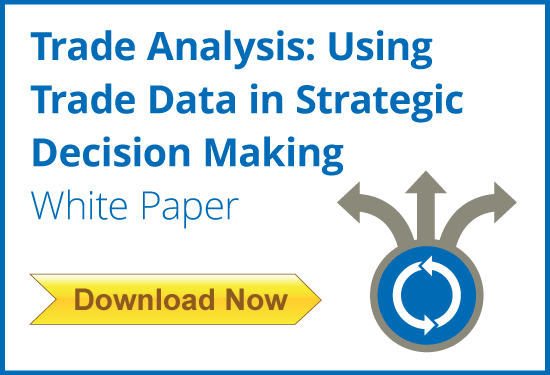3 Keys to Understanding Trade Data & Its Applications
by Sarah Schmidt
September 6, 2018
Chances are, you’ve heard a lot of rhetoric about trade lately. While it can serve as a contentious debate topic, international trade is – generally speaking – viewed as an integral component of a healthy global economy. However, mounting tensions over the Trump administration’s tariffs (and in turn, retaliatory tariffs from other countries) over the past few months have added a few wrinkles to the free back-and-forth flow of goods and services that the US has typically enjoyed with its trade partners.
While trade is incredibly important, the data associated with it is often complex and difficult for the average consumer to dissect. However, having a basic understanding of how trade data works can help individuals and organizations accrue a better small- and large-scale picture of the global economic climate – tariffs and all – and as a result make better strategic decisions. Here are three key factors to understanding trade data and how to use it.
1. Trade Codes
Over the past few months, you’ve probably seen a statistic or two similar to the one quoted in this and other recent tariff-related news articles: “China buys so much soy from the United States – $14 billion last year – that it can hardly switch to new suppliers overnight.”
The value and the parties involved are easy enough to comprehend. But where did the information come from? The answer lies in trade codes.
Take the smartphone, for example (incidentally, the smartphone is the largest single product export from China to the US). Before it hits the shelf, the device is catalogued according to a tiered coding process that identifies it by both broad and specific product categories. These codes are reported to trade databases by the country of export, after which users can search the databases for their product of interest – in this case, the smartphone – and successfully track its movement between trade partners.
It sounds simple in theory. But there’s a little more to it – different trade organizations sometimes have different systems for cataloguing, though the Harmonized Tariff Systems codes – a compendium of 10-digit “HTS” or shorter, less specific “HS” numerical product designations – are the most commonly used among them.
2. Trade Databases
So you have your product and code, and you know which countries you’d like to track for trade flow. Where do you look first?
There are a few different options. Free databases include:
- UN Comtrade, which covers global imports and exports
- USITC, which records trade between the US and its partners
- Eurostat, which documents trade between the European Union and its partners
While each database has its own benefits and drawbacks, all serve as excellent starting points for a beginner’s deep dive into trade between global markets.
3. Trade Data & Global Tariffs
Armed with an understanding of trade codes and the databases that house them, how can you use trade data in real-time to make strategic decisions – particularly when several world powers are embroiled in a contentious trade war with no end in sight?
In broad context, trade data can be used to determine historical product consumption and supply chain flow by market, which can then be factored into future demand calculations. For manufacturers in low- or high-growth industries, those calculations might play into decisions about when and where to consolidate or expand.
When it comes to tariffs specifically, understanding trade codes and how they work can help affected firms circumvent the new surtaxes and mitigate their impact on the bottom line. Options available to these companies include:
- obtaining more favorable product codes/classifications subject to lower duty rates
- reorganizing the supply chain and shifting a product’s country of origin
- strategies to lower product value, in turn lowering the tariff rate (calculated from percent of value)
With the global trade climate more fraught than ever, there may come a day when tariffs are virtually inescapable. However, in the interim, manufacturers and suppliers can leverage trade data for the key strategic insights that will help shield them from short-term consequences.
To Learn More
Interested in taking a deeper dive into trade data and analysis? For more information on how to read trade codes, use trade databases, and understand how trade data insights can help you make business decisions, download the newest white paper from Freedonia Custom Research, “Trade Analysis: Using Trade Data in Strategic Decision Making”.
While several online databases offer access to large volumes of raw trade data, it is the additional analysis and primary research available that sets Freedonia Custom Research apart. Freedonia Custom Research’s analysts average more than five years of experience in market intelligence, with a diverse set of technical and business-related backgrounds that allows for flexibility in how each unique project is approached and executed. Additional insights into changes in trade flow patterns, such as the impact on individual markets or competitors, can be compiled via Freedonia Custom Research's primary and secondary research techniques including competitive intelligence/market share and value chain information, as well as voice-of-market insights.
About the Author:
Alecia Mouhanna is a Corporate Analyst at the Freedonia Group, where she researches and writes about a diverse range of topics, including construction and building materials, chemicals, packaging, and more.
Have unique research needs?
Freedonia Custom Research listens intently to your needs and objectives. Then we work diligently to define and deliver a service to meet them.Subscribe to Our Blog
Stay up to date with the latest information about new market research and news in areas relevant to your business from our analysts and team members.Freedonia Group Blog Subscription
Provide the following details to subscribe.
